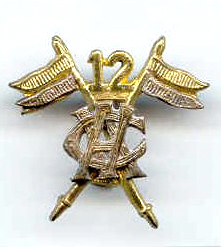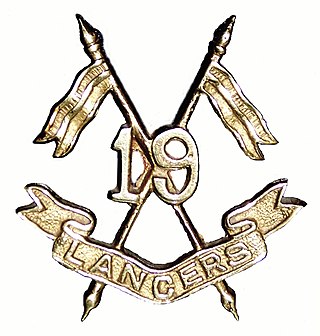
The Indian Army is the land-based branch and the largest component of the Indian Armed Forces. The President of India is the Supreme Commander of the Indian Army, and its professional head is the Chief of Army Staff (COAS), who is a four-star general. Two officers have been conferred with the rank of field marshal, a five-star rank, which is a ceremonial position of great honour. The Indian Army was formed in 1895 alongside the long established presidency armies of the East India Company, which too were absorbed into it in 1903. The princely states had their own armies, which were merged into the national army after independence. The units and regiments of the Indian Army have diverse histories and have participated in several battles and campaigns around the world, earning many battle and theatre honours before and after Independence.
An armoured corps is a specialized military organization whose role is to conduct armoured forces. The units belonging to an armoured corps include military staff, and are equipped with tanks and other armoured fighting vehicles, as well as supporting vehicles.

The Battle of Chawinda was a major engagement between Pakistan and India in the Second Kashmir War as part of the Sialkot campaign. It is well known as being one of the largest tank battles in history since the Battle of Kursk, which was fought between the Soviet Union and Nazi Germany in World War II.

45 Cavalry is an armoured regiment in the Armoured Corps of the Indian Army. The regiment distinguished itself in operations during the 1971 Indo-Pakistan War winning one Maha Vir Chakra.

The Indian Army Armoured Corps is one of the combat arms of the Indian Army. Tracing its origins from the first regiment formed in 1776, the present corps was formed in 1947 from two-thirds of the personnel and assets of the British Indian Army's Indian Armoured Corps. It currently consists of 67 armoured regiments, including the President's Bodyguards.

The 6th Armoured Division is a Pakistan Army armoured division currently based in Gujranwala, in Punjab Province.

The X Corps is a corps of the Pakistan Army, currently assigned in Rawalpindi, Punjab Province of Pakistan. It is one of two corps that are currently active in Kashmir. One of its most important brigades, the 111th Infantry Brigade in Rawalpindi, is assigned Presidential Guard duties along with ceremonial duties for foreign dignitaries arriving in Pakistan.The current commander of this corps is Lt. Gen Shahid Imtiaz.

The I Corps, also known as I Strike Corps, of the Pakistan Army headquartered in Mangla, Azad Kashmir Territory of Pakistan. Known as I Strike Corps, it is one of two strike corps within its ten-manoeuvre Army corps. The I Strike Corps is one of the oldest and major formations of Pakistan Army.

The Guides Cavalry (Frontier Force) is an armoured regiment of the Pakistan Army which was raised in 1846 as The Corps of Guides. During more than a hundred and fifty years of military service, the regiment has earned the reputation of one of the most renowned military units in the world.

The 12th Cavalry Sam Browne's Cavalry (Frontier Force) is an armoured regiment of Pakistan Army. It was formed in the British Indian army in 1922 by the amalgamation of 22nd Sam Browne's Cavalry (Frontier Force) and 25th Cavalry (Frontier Force).

The 15th Lancers (Baloch) is an armoured regiment of the Pakistan Army. It was formed in 1922 by the amalgamation of the 17th Cavalry and the 37th Lancers (Baluch Horse).

The 16th Light Cavalry is a regiment of the Armoured Corps, a primary combat arm of the Indian Army. Prior to India gaining independence from the British in 1947, it was a regular cavalry regiment of the British Indian Army. It was formed in 1776 and is the oldest armoured regiment raised in India. The 16th Light Cavalry saw service in a number of conflicts ranging from the Second Anglo-Mysore War in 1781 to World War II. It has a number of battle honours including "Punjab 1965" earned during the Indo-Pakistani War of 1965.

The 19th Lancers is an armoured regiment of the Pakistan Army. Before 1956, it was known as 19th King George V's Own Lancers, which was a regular cavalry regiment of the British Indian Army. It was formed in 1922, by the amalgamation of 18th King George's Own Lancers and 19th Lancers (Fane's Horse). On Partition of India in 1947, the regiment was allotted to Pakistan.

The 20th Lancers is an armoured regiment of the Pakistan Army.

The II Corps, also known as II Strike Corps is a corps of Pakistan Army stationed in Multan, Punjab Province of Pakistan. The corps was active in Pakistan's theatre in War on Terror where its administrative divisions and brigades led numerous operations in the Federally Administered Tribal Areas of Pakistan. The corps is currently commanded by Lieutenant-General Akhtar Nawaz. The longest-serving commander of this corps was Lieutenant-General Rahimuddin Khan who commanded for five and half years.

The Armoured Corps of the Pakistan Army is a combat branch tasked with armoured warfare. Equipped with more than 3,742 main battle tanks, the corps is headquartered in the garrison town of Nowshera, Khyber-Pakhtunkhwa. The corps has only administrative control of its component regiments. The regiments are deployed in a number of field formations including two armoured divisions, two mechanised divisions, and a number of independent armoured brigades.

The 13th Lancers is an armoured regiment of Pakistan Army. It was formed in 1923 as 13th Duke of Connaught's Own Lancers by the amalgamation of 31st Duke of Connaught's Own Lancers and 32nd Lancers. On Partition of India in 1947, the regiment was allotted to Pakistan.
Lieutenant General Khem Karan Singh MVC was a General Officer in the Indian Army. He was awarded Padma Bhushan for his services to the nation during the 1971 war. He also received Maha Vir Chakra for his services during 1965 Indo-Pakistan war.

75 Armoured Regiment is an armoured regiment of the Indian Army.
The 4th Cavalry is an armoured regiment of the Pakistan Army. It was previously a regular cavalry regiment of the British Indian Army. The regiment suffered heavy losses as part of the 1st Armoured Division in the Battle of Asal Uttar during the Indo-Pakistani War of 1965. It was raised again in 1980.













